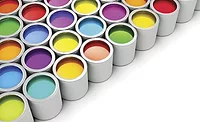New Low-VOC Coalescents for Exterior Coatings
Dibenzoate Technology - A Viable Alternative

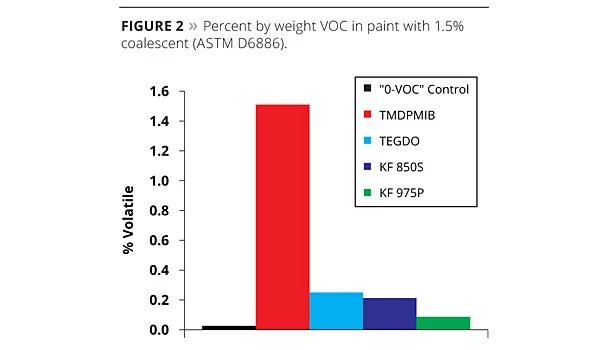

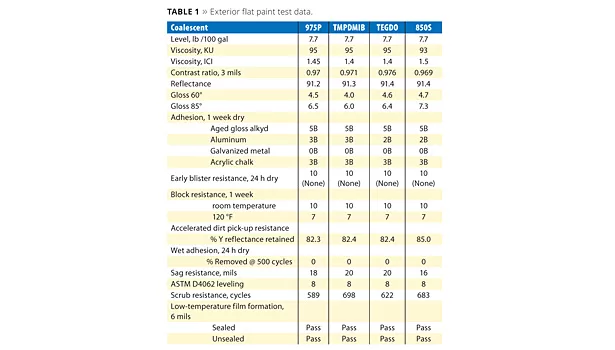

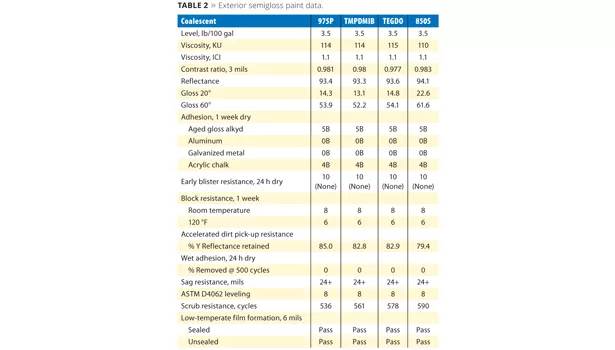
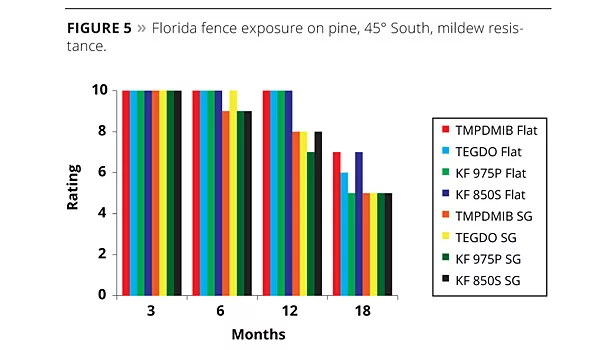
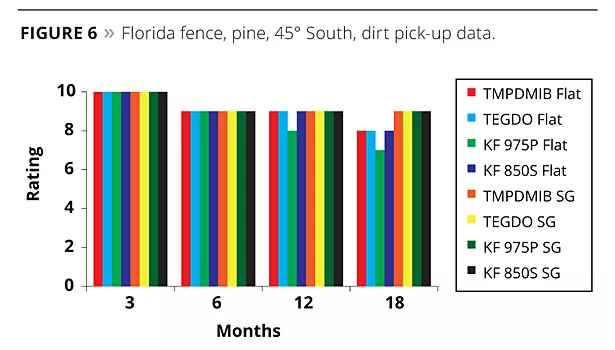
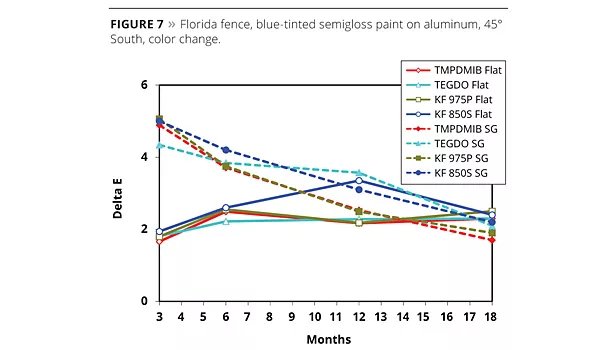
As part of the chemical industry’s larger initiative focused on health and environmental issues, the coatings industry has spent much of the past decade trying to identify ways to reduce VOCs. Historically, high-VOC coalescents were used in conjunction with high-Tg polymers to provide the type of performance benefits required by paint formulators and end users.
Over the years, a variety of approaches have been adopted in an effort to lower VOC levels. One approach involves the substitution of harder polymers with softer ones that require significantly lower levels of coalescents. Another method involves the substitution of high-VOC ingredients, such as coalescents, with low-VOC alternatives. In some instances, a combination of both approaches has been adapted. However, the effort to reduce VOCs by using softer polymers and/or low-VOC coalescents sometimes results in a sacrifice in performance.
A major concern of formulators is that the less-volatile plasticizers used to aid in film formation would remain in the film and soften it, thus potentially resulting in unsatisfactory performance with regard to certain properties such as dirt pick up, blocking and film hardness. The softening effect of plasticizers is well noted in applications such as vinyl, adhesives and sealants where typically 10-80 phr plasticizers are incorporated into the formulation, as compared to the 1-2% level typically needed to coalesce coatings. Research into new materials was undertaken to document performance, address these concerns,1 and optimize other performance properties.
In 2010 a new low-VOC dibenzoate tri-blend platform was introduced as a potential coalescent/plasticizer for use in coatings. Evaluations of new formulations were initially conducted to determine their utility in interior architectural coatings in a vinyl acrylic system (12 °C Tg), acrylic emulsion (7 °C Tg ) and an acrylic copolymer (31°C Tg).2,3 The data presented were positive and demonstrated excellent film formation, freeze-thaw resistance, improved scrub resistance and gloss when tested side-by-side with a wide range of products from traditional high-VOC coalescents, such as TMPDMIB, and other lower-VOC coalescents. Subsequent evaluations in an OPV formulated with a hard styrene-acrylic copolymer (89 °C Tg) further showed better performance than traditional glycol ethers, providing good König hardness, dry time, water resistance and gloss.4,5 Prompted by these positive results, it was decided to undertake additional study of two of the newer dibenzoate compositions – including the new patent-pending K-FLEX 975P – and evaluate their performance in exterior coatings.
The purpose of this article, as part of a continuum of low-VOC dibenzoate blend evaluations, is to provide an overview of how well these newer, low-VOC coalescents perform in exterior paint applications.6,7 A full range of tests was run, including evaluation of the paint and dried film performance such as adhesion, gloss, scrub, dirt pick up and hardness, validating the performance of the dibenzoate platform.
Evaluation
Two common latex paint emulsions were selected to conduct the screen of dibenzoate plasticizers in exterior paint. A standard acrylic emulsion (12 °C Tg) was selected as the polymer for a flat exterior formulation, and an acrylic emulsion (9 °C Tg) was selected for an exterior semigloss formulation. The key formulation variables included:
- Flat paint – Volume solids = 38.2% and PVC = 46.0%
- Semigloss – Volume solids = 33.7% and PVC = 29.8%
- The complete generic starting formulations are listed in Appendix 1. Other than a determination of the proper coalescent level required, no attempt was made to formulate to any of the coalescents. The following plasticizer/coalescents were evaluated:
- 2,2,4-Trimethyl-1,3-pentanediol monoisobutyrate (TMPDMIB) is the standard in the industry and is widely used despite the fact that it is 100% volatile according to the EPA 24 ASTM D2369 test method;
- Triethylene glycol di-2-ethylhexanoate (TEGDO) is a newer, lower-VOC coalescent;
- A newer commercial blend of dipropylene glycol dibenzoate and diethylene glycol dibenzoate (850S, Emerald Kalama Chemical);
- A recently launched patent-pending composition based on a combination of three dibenzoate esters (975P, Emerald Kalama Chemical): different ratios of esters.
The evaluation consisted of three segments. In the first segment data was gathered on the VOCs of the plasticizers/coalescents as determined by ASTM D2369 and D6886. The second part of the evaluation focused on the data for wet and dry paint. Specifically, evaluation for the wet paint included viscosity, low-temperature film formation, sag and leveling. For the dry paint, the focus was on contrast ratio, reflectance, gloss, dry adhesion and early blister, accelerated dirt pick up, wet adhesion, scrub and pendulum hardness development.
The last segment highlighted exterior exposure on a fence in central Florida with the following panels being evaluated:
- South 45° – Southern pine, self primed, two coats total;
- North 90° – Southern pine, primed with a waterborne acrylic primer, with two coats of paint;
- South 90° – Southern pine, two coats self primed dried at 40 °F;
- South 45° – Aluminum panels coated with phthalo blue-tinted paint (semigloss only).
The painted wood panels were rated visually for mildew growth, dirt pick up, delamination and general appearance. Details of the test methods are listed in Appendix 2.
Segment 1
Plasticizer/Coalescent Volatility
Although the amount of coalescent used in a gallon of paint is not significant, it is essential to attempt to minimize it and reduce every component that contributes to VOC content. Even a raw material that is generally used at a relativity low level can be altered to significantly reduce the VOC level.
Oven tests provide a standard method for comparing the VOC contribution of volatile and semi-volatile components. Figure 1 illustrates the volatility of the coalescents in this study according to the EPA 24 ASTM D2369 method.
In addition to this test, ASTM D6886 (GC method) is often used to provide meaningful data. A quart of zero-VOC paint was purchased from a big box store for this study. Then 1.5 percent by weight of the coalescents was added to the paint utilizing the ASTM D6886 GC method.
Figures 2 and 3 illustrate the results of the testing. It is interesting to note that virtually all of the TMPDMIB was found as VOC using this method; only some of the low-VOC coalescents were found.
In any event, all of the low-VOC coalescents proved to be low in volatility compared to the TMPDMIB control. As a result, all would contribute very little to the VOC of a coating, especially at the low level of use.
Segment 2
Coalescent Efficiency
Prior to initiating the paint evaluation, the efficiency of each coalescent was determined in both base paint formulations. The efficiency level of each coalescent was determined by the amount of coalescent required to obtain proper film formation at 40 °F (4 °C) in each of the two paints. The level of coalescents in pounds per 100 gallons of paint is indicated in the tables.
Wet Paint and Dried Film Characteristics
As seen in Tables 1 and 2, overall there are not a lot of differences between all the paints tested. While this may not seem to be an advantage for the dibenzoates evaluated, it actually is a positive result when considering that TMPDMIB has been the standard coalescent in the industry for more than a half a century, and TEGDO is well recognized as a good low-VOC plasticizer/coalescent in the market.
As always, there are some pluses and minuses in the data. Equal efficiency in low-temperature filming certainly is a plus for the dibenzoates. There are no specific advantages in the wet paint property tests, but in the semigloss paint there are some advantages in the accelerated dirt pick-up test.
The gloss in the semigloss 850S paint is somewhat better, indicating that it is excellent for film formation. The 850S flat paint seems to have better scrub resistance than the controls. This is a plus since the dibenzoates (like all plasticizers) tend to be more permanent than coalescents, such as the TMPDMIB control. Although this was expected to be an issue with regard to the physical properties, the data confirmed otherwise.
Although plasticizers will soften polymers, they can also toughen at the levels used to coalesce in paint (Figure 4).
Segment 3
Exterior Exposure – Florida Fence
This third segment is a key part of the evaluation because, as was stated earlier, plasticizers are more permanent than coalescents. Thus, it would be logical to consider this to be a drawback in exterior paint. Expected performance issues might arise since paint with plasticizers would be softer and would, theoretically, create issues with dirt pick up or mildew resistance.
Although the full term of the Florida fence testing is two years, only 18 months of data were available at the time of this writing. However, sufficient data are available to describe the performance of the dibenzoate blends.
The paints that were dried at 40 °F on pine with South vertical exposure are doing very well. No significant delamination, mildew growth, dirt pick up or degradation have been noted. The same is true of the paint on the North vertical exposed pine. This is not so for the panels exposed at 45°. Figure 5 documents mildew resistance and the general appearance of these panels.
The mildew growth seemed to accelerate after 18 months of exposure. In truth, all of the paints have failed by that point, indicating the biocide package was most likely the issue rather than poor film formation or plasticizer migration to the surface. Interestingly, the dirt pick up on the panels was not as significant an issue as expected (Figure 6). The flat paints faired slightly worse in dirt pick up than the semigloss paints.
On the aluminum panels exposed at 45°, the flat and semigloss paints were tinted blue. In both the flat and semigloss paints the change in color was similar overall (Figure 7). In the flat paints there were subtle differences in color fade, but the 975P paint tracks well with the TMPDMIB.
Conclusion
The data presented in this evaluation indicate that the dibenzoate tri-blend and the dibenzoate di-blend provide the proper coalescence in the exterior paints tested. Particular attention was paid to hardness, blocking and dirt pick up. Given concerns that low-VOC materials naturally have higher permanence than high-VOC coalescents, and because of this would soften the film, it was thought that these properties may not be up to performance expectations. The data in any of the studies to date indicate those concerns to be unsubstantiated relative to this technology platform. Even though the dibenzoate blends are very low in VOC content, they offer additional performance options over the low-VOC control, triethylene glycol di-2-ethylhexanoate. In addition, the study indicated the new dibenzoate triblends could deliver superior performance benefits in gloss and scrub resistance as compared to some of the traditional coalescent choices. Both products appear to provide paint formulators with good alternatives to existing volatile coalescents and current-generation, low-VOC coalescents.
Looking for a reprint of this article?
From high-res PDFs to custom plaques, order your copy today!




